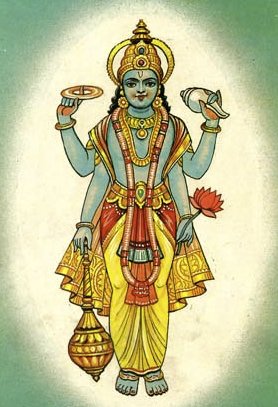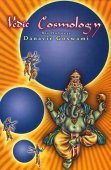Sakshat, Sākṣāt: 17 definitions
Introduction:
Sakshat means something in Hinduism, Sanskrit, Jainism, Prakrit, Marathi, Hindi, Tamil. If you want to know the exact meaning, history, etymology or English translation of this term then check out the descriptions on this page. Add your comment or reference to a book if you want to contribute to this summary article.
The Sanskrit term Sākṣāt can be transliterated into English as Saksat or Sakshat, using the IAST transliteration scheme (?).
In Hinduism
Vaishnavism (Vaishava dharma)
Source: Pure Bhakti: Brhad BhagavatamrtamSākṣāt (साक्षात्) refers to:—Directly. (cf. Glossary page from Śrī Bṛhad-bhāgavatāmṛta).

Vaishnava (वैष्णव, vaiṣṇava) or vaishnavism (vaiṣṇavism) represents a tradition of Hinduism worshipping Vishnu as the supreme Lord. Similar to the Shaktism and Shaivism traditions, Vaishnavism also developed as an individual movement, famous for its exposition of the dashavatara (‘ten avatars of Vishnu’).
Shaktism (Shakta philosophy)
Source: Google Books: ManthanabhairavatantramSākṣāt (साक्षात्) refers to “one who is directly apparent”, according to the Manthānabhairavatantra, a vast sprawling work that belongs to a corpus of Tantric texts concerned with the worship of the goddess Kubjikā.—Accordingly, “In the venerable seat of Oṃkāra, the talented Vijayā, who is (the energy) Śānti, pulses radiantly within. During the Kṛta Age (the Siddha) is the tranquil Ananta directly apparent (sākṣāt—sākṣādananta). The one called Khagendra (is the Siddha) in the Tretā Age and (within him) in the sacred seat of Jāla is the Vidyā which is part of the maṇḍala and is impelled by the (most) excellent Void. I bow to Piṅgala who shines with the radiance of the Moon and Sun and is the incarnation (called) Kūrma”.

Shakta (शाक्त, śākta) or Shaktism (śāktism) represents a tradition of Hinduism where the Goddess (Devi) is revered and worshipped. Shakta literature includes a range of scriptures, including various Agamas and Tantras, although its roots may be traced back to the Vedas.
Purana and Itihasa (epic history)
Source: archive.org: Shiva Purana - English TranslationSākṣāt (साक्षात्) or Sākṣātsraṣṭṛ refers to the “direct (creator)” (of Prakṛti and Puruṣa), according to the Śivapurāṇa 2.5.6 (“Prayer to Śiva”).—Accordingly, as the Gods eulogized Śiva: “Obeisance to you, the soul of all, obeisance to Śiva the remover of distress, obeisance to the blue-necked Rudra, obeisance to the knowledge-formed Śiva of great mind. You are our ultimate goal for ever. You are the remover of all adversities. O destroyer of the enemies of the gods, you alone are to be respected by us always. You are the beginning. You are the primordial being. You are self-bliss. You are the everlasting lord. You are the lord of the universe, the direct creator (sākṣāt-sraṣṭṛ) of Prakṛti and Puruṣa. [...]”.

The Purana (पुराण, purāṇas) refers to Sanskrit literature preserving ancient India’s vast cultural history, including historical legends, religious ceremonies, various arts and sciences. The eighteen mahapuranas total over 400,000 shlokas (metrical couplets) and date to at least several centuries BCE.
In Jainism
General definition (in Jainism)
Source: The University of Sydney: A study of the Twelve ReflectionsSākṣāt (साक्षात्) refers to “directly” (e.g., ‘that which should be learned directly’), according to the 11th century Jñānārṇava, a treatise on Jain Yoga in roughly 2200 Sanskrit verses composed by Śubhacandra.—Accordingly, “Breath control is praised by mendicants, whose own opinions are well-established, for the accomplishment of meditation and for steadiness of the inner self. Therefore, it should be learned directly (sākṣāt) and before [meditation] by the wise. Otherwise, even a little mastering of the mind cannot be done. It is considered by the teachers of old as threefold in accordance with the difference in characteristics. There is inhalation, holding and, immediately after that, exhalation”.

Jainism is an Indian religion of Dharma whose doctrine revolves around harmlessness (ahimsa) towards every living being. The two major branches (Digambara and Svetambara) of Jainism stimulate self-control (or, shramana, ‘self-reliance’) and spiritual development through a path of peace for the soul to progess to the ultimate goal.
Languages of India and abroad
Marathi-English dictionary
Source: DDSA: The Molesworth Marathi and English Dictionarysākṣāt (साक्षात्).—prep (S) Before, in the presence of, evidently to the sight or sense of. 2 ad Manifestly, obviously, evidently. 3 In, by, or through one's own self or person. Ex. dusaṛyā kōṇhāsa pāṭhavūṃ nakā tumhī sā0 jāūna pāhā; hēṃ ghara myāṃ sā0 bāndhalēṃ.
Source: DDSA: The Aryabhusan school dictionary, Marathi-Englishsākṣāt (साक्षात्).—prep Before. ad Evidently. In, by or through one's own person.
Marathi is an Indo-European language having over 70 million native speakers people in (predominantly) Maharashtra India. Marathi, like many other Indo-Aryan languages, evolved from early forms of Prakrit, which itself is a subset of Sanskrit, one of the most ancient languages of the world.
Sanskrit dictionary
Source: DDSA: The practical Sanskrit-English dictionarySākṣāt (साक्षात्).—ind.
1) In the presence of, before the very eyes, visibly, openly, evidently.
2) In person, actually in bodily form; साक्षात् प्रियामुपगतामपहाय पूर्वम् (sākṣāt priyāmupagatāmapahāya pūrvam) Ś.6.15; 1.6.
3) Directly. In comp. it is often translated by 'incarnate'; साक्षाद्यमः (sākṣādyamaḥ); or by 'open, direct'; तत्साक्षात् प्रति- षेधः कोपाय (tatsākṣāt prati- ṣedhaḥ kopāya) Mālatīmādhava (Bombay) 1.11. (sākṣātkṛ
1) to see with one's own eyes, realize personally.
2) to have an intuitive perception or manifestation of; sākṣātkṛtadharmāṇa ṛṣayaḥ Uttararāmacarita 7.
3) To experience a result of or reward for; sākṣyātkṛtaṃ me paribarhaṇaṃ hi Bhāgavata 5.5.27;1.22.2.)
Source: Cologne Digital Sanskrit Dictionaries: Shabda-Sagara Sanskrit-English DictionarySākṣāt (साक्षात्).—Ind. 1. Before, in presence, in sight. 2. As, like. 3. Actually in person. 4. Evidently, manifestly, directly. E. sa for saha with, akṣa the eye, at to go or to be, aff. kvip; or saha akṣati akṣ-āti sādeśaḥ .
Source: Cologne Digital Sanskrit Dictionaries: Benfey Sanskrit-English DictionarySākṣāt (साक्षात्).—abl. sing. of sa -akṣa, adv. 1. In presence, [Nala] 24, 13 (in their presence, being present); before, eye to eye, [Indralokāgamana] 2, 16. 2. From (cf. sakāśāt, s.v. sakāśa), [Arjunasamāgama] 1, 12. 3. Manifestly, evidently, visibly, [Mānavadharmaśāstra] 2, 237; [Pañcatantra] 46, 6; [Nala] 1, 4 (sakṣād -iva manuḥ, like an embodied Manu); with one’s own eyes, [Pañcatantra] 197, 12. 4. Openly, [Mālatīmādhava, (ed. Calc.)] 6, 13. 5. As, like.
Source: Cologne Digital Sanskrit Dictionaries: Cappeller Sanskrit-English DictionarySākṣāt (साक्षात्).—[adverb] with or before the eyes, i.e. plainly, actually, exactly, immediately, directly, in person. With bhū appear in person; [with] kṛ take a view of, put before the eyes, witness, notice, call to mind.
Source: Cologne Digital Sanskrit Dictionaries: Monier-Williams Sanskrit-English Dictionary1) Sākṣāt (साक्षात्):—[from sākṣa] a ind. ([ablative] of sākṣa above) with the eyes, with one’s own eyes, [Kāvya literature; Kathāsaritsāgara; Sarvadarśana-saṃgraha]
2) [v.s. ...] before one’s eyes, evidently, clearly, openly, manifestly, [Atharva-veda] etc. etc.
3) [v.s. ...] in person, in bodily form, personally, visibly, really, actually, [Mahābhārata; Kāvya literature] etc.
4) [v.s. ...] immediately, directly, [Sarvadarśana-saṃgraha; Manvarthamuktāvalī, kullūka bhaṭṭa’s Commentary on manu-smṛti]
5) [from sākṣa] b in [compound] with forms of √kṛ.
Source: Cologne Digital Sanskrit Dictionaries: Yates Sanskrit-English DictionarySākṣāt (साक्षात्):—prep. Before, in sight; as, like; manifestly.
Source: DDSA: Paia-sadda-mahannavo; a comprehensive Prakrit Hindi dictionary (S)Sākṣāt (साक्षात्) in the Sanskrit language is related to the Prakrit word: Sakkhaṃ.
[Sanskrit to German]
Sanskrit, also spelled संस्कृतम् (saṃskṛtam), is an ancient language of India commonly seen as the grandmother of the Indo-European language family (even English!). Closely allied with Prakrit and Pali, Sanskrit is more exhaustive in both grammar and terms and has the most extensive collection of literature in the world, greatly surpassing its sister-languages Greek and Latin.
Hindi dictionary
Source: DDSA: A practical Hindi-English dictionarySākṣāt (साक्षात्):—(adv) in the presence of, in person, visibly; (a) manifest, tangible, visible; ~[kāra] an interview; ~[kārī] an interviewer; ~[kṛta] interviewed.
...
Tamil dictionary
Source: DDSA: University of Madras: Tamil LexiconSākṣāt (ஸாக்ஷாத்) adverb < sākṣāt.
1. Before one’s eyes; கண்ணுக்கெதிரில். [kannukkethiril.]
2. Directly; நேராக. அவன் எனக்கு ஸாக்ஷாத் ஸஹோ தரன். [neraga. avan enakku sagshath saho tharan.]
3. Exactly; சரியாக. [sariyaga.]
4. See சாட்சாத்து. [sadsathu.]
Tamil is an ancient language of India from the Dravidian family spoken by roughly 250 million people mainly in southern India and Sri Lanka.
See also (Relevant definitions)
Starts with (+9): Cakshat, Sakshaddharma, Sakshat-darshana, Sakshata, Sakshatam, Sakshatapatrahasta, Sakshatkara, Sakshatkaram, Sakshatkarana, Sakshatkarata, Sakshatkaravant, Sakshatkaravat, Sakshatkari, Sakshatkarin, Sakshatkarisu, Sakshatkartar, Sakshatkartavya, Sakshatkartri, Sakshatkri, Sakshatkrita.
Full-text (+35): Asakshat, Sakshatkara, Sakshatkriya, Sakshatkarana, Sakshatkarata, Sakshatkaravat, Sakshatkaram, Sakshatkarin, Sakshatkartavya, Sakshatkartri, Sakshatkritadharman, Sakshatkriti, Sakshatpurushottamavakya, Sakshatkrita, Sakshad, Sakshakaroti, Asakshya, Sakshatkri, Asakshika, Sakkham.
Relevant text
Search found 40 books and stories containing Sakshat, Saagshaat, Saakshaat, Sagshat, Sākṣāt, Saksat; (plurals include: Sakshats, Saagshaats, Saakshaats, Sagshats, Sākṣāts, Saksats). You can also click to the full overview containing English textual excerpts. Below are direct links for the most relevant articles:
Garga Samhita (English) (by Danavir Goswami)
Verse 5.15.26 < [Chapter 15 - Seeing Sri Radha]
Verse 5.13.28 < [Chapter 13 - The Arrival of Sri Uddhava]
Verse 5.13.2 < [Chapter 13 - The Arrival of Sri Uddhava]
Yoga Vasistha [English], Volume 1-4 (by Vihari-Lala Mitra)
Chapter CXXI - Continuation of the same < [Book VI - Nirvana prakarana part 1 (nirvana prakarana)]
Chapter CCX - Refutation of the conception of a duality in unity < [Book VII - Nirvana prakarana part 2 (nirvana prakarana)]
Brihad Bhagavatamrita (commentary) (by Śrī Śrīmad Bhaktivedānta Nārāyana Gosvāmī Mahārāja)
Verse 2.1.15 < [Chapter 1 - Vairāgya (renunciation)]
Verse 2.2.232 < [Chapter 2 - Jñāna (knowledge)]
Verse 2.2.44 < [Chapter 2 - Jñāna (knowledge)]
Sahitya-kaumudi by Baladeva Vidyabhushana (by Gaurapada Dāsa)
Text 2.8 < [Chapter 2 - The Natures of Words (śabda)]
Text 11.41 [Praharṣaṇa] < [Chapter 11 - Additional Ornaments]
Text 7.107 < [Chapter 7 - Literary Faults]
Bhajana-Rahasya (by Srila Bhaktivinoda Thakura Mahasaya)
Related products
